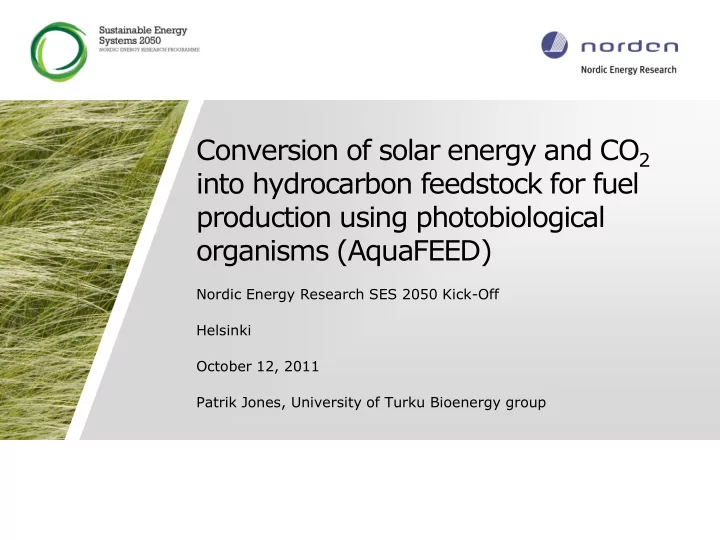

Conversion of solar energy and CO 2 into hydrocarbon feedstock for fuel production using photobiological organisms (AquaFEED) Nordic Energy Research SES 2050 Kick-Off Helsinki October 12, 2011 Patrik Jones, University of Turku Bioenergy group
Rationale • Photobiological organisms are well-suited for conversion of solar energy into hydrocarbon feedstock • Terrestrial biomass has limitations in terms of solar energy conversion efficiency and land use • Aquatic photobiology has potentially greater overall conversion efficiency but remains largely untested • Can aquatic photobiology complement terrestrial biomass for hydrocarbon fuel production? 2
Concept Light CO 2 Photo- Ferment Bio- FUEL plant Reactor CO 2 Feedstock FEEDSTOCK Synthetic FUEL Biomass Glycogen pathway CO 2 CO 2 Light PSI/II 3
Objectives and Goals WP1 Strain evaluation, Fuel production (WPL TY1) Adaptive Engineering evolution synthetic CO 2 WP2 Optimization photosynthesis (WPL TY2) WP3 Optimization CO 2 -metabolism(WPL UU1) WP4 Optimization carbohydrate metabolism (WPL KU) Engineering Combine best native CO 2 CO 2 strategies Extraction, Cyanobacteria cultivation Hydrolysis PS genetic engineering Combinatorial Algae Fermentative Engineering and cultivation fuel synthesis Evaluation Evaluation of Reference system Characterization target process of PS/materials Direct fuel synthesis Engineering Materials Understanding carbohydrate development regulation flux 4
Challenges I • Biology has evolved for it’s own purpose, not for our (humans) purpose • Metabolism of the entire cell and communities depend on concerted action and interaction between thousands of genes, proteins and metabolites – most of which we know nothing about • To reengineer biological organisms for our purpose is therefore a substantial challenge • Still, many examples exist where only minor engineering have resulted in biotechnologically useful strains 5
Challenges II • The economic feasibility of utilizing photobiological systems in commercial production of low-value end- products is still to be demonstrated (as far as aware) • This project targets improvement in the overall solar energy and carbon conversion efficiency of a solar- glycogen-fuel production-chain • The limit in conversion efficiency, of the entire process, at which economic feasibility is reached is currently unknown. We hope to provide at least part of the solution towards such an answer within this project 6
Recommend
More recommend